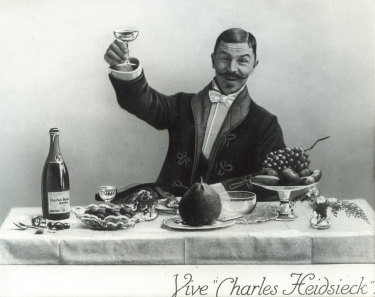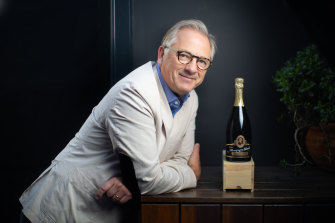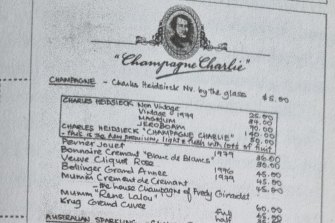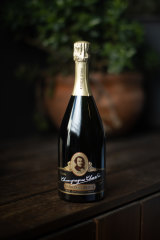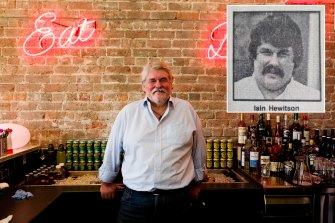Champagne Charlie bubbles up in Melbourne, a town that enjoys a glass of fizz
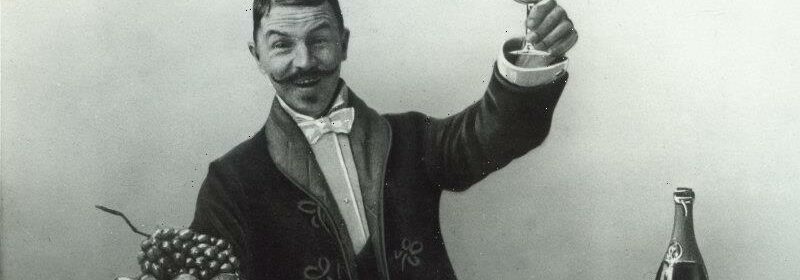
Melbourne has always had a taste for champagne, particularly the good stuff.
Amid the excess of Victoria’s gold rush, French fizz was imported to quench the thirst of a newly wealthy Melbourne populace. In the 1980s, another dizzying boom time, the bankers and celebrities were drinking plenty of it.
One of the cuvees popular in both eras was Charles Heidsieck, whose eponymous French wine merchant founder was nicknamed “Champagne Charlie” after introducing bubbly to the United States in the 1850s.
Charlies Heidsieck, nicknamed “Champagne Charlie”.
His American adventures during the Civil War, including imprisonment on charges of spying for France, inspired songs, books and even a French-Canadian miniseries starring Hugh Grant.
Heidsieck never toured Australia but his champagne arrived here in 1855, just four years after he founded his champagne maison, according to an ad that Thistlewaite and Sayers, of 8 Queens Street, placed in The Argus. And Heidsieck’s son, also Charles, made it to Victoria in 1909.
His visit received extensive coverage in the local press. Journalists reported Heidsieck’s compliments of Ballarat’s wide avenues (“like the Champs-Elysees”) and predictions for local wines.
“They are quite distinct to the connoisseur,” The Weekly Times reported at the time. “Under distinctive names, the Australian wines, in Mr Heidsieck’s opinion, should make a name for the country.”
Stephen Leroux, managing director of Charles Heidsieck, with a bottle of Champagne Charlie.Credit:Simon Schluter
While Heidsieck was right about the rise of Australian wine (although “sparkling white” is hardly a distinctive name), the country is still fond of a glass of chilled champagne.
Australia is the sixth-largest market outside France for champagne by volume. Nearly 10 million bottles were imported in 2021 — up by 16.5 per cent on the year before.
The impact of COVID-19 on the hospitality industry appears to have eased, and luxury brands are reporting a strong return to pre-pandemic sales.
The wine list for Iain Hewitson’s restaurant Champagne Charlie in 1984.
“We bounced back plus 80 per cent,” Stephen Leroux, managing director of Charles Heidsieck, said in Melbourne last week of post COVID-19 lockdown sales.
“We lost more [than other brands], but we bounced back much, much higher. There’s not enough Charles to sell to any kind of customer … we’re very choosy.”
As part of its push into the Australian market, Charles Heidsieck is releasing its “Champagne Charlie” multi-vintage cuvee for the first time since 1985.
There are just 3000 bottles of Champagne Charlie for sale around the world.Credit:Simon Schluter
Champagne Charlie is pricey, selling for more than $900 a bottle. There are only 3000 bottles available around the world and just 300 set aside for Australia.
The wine is a blend of 80 per cent reserve wines and 20 per cent pinot noir from the 2016 harvest.
“It’s really a very, very, very deep blend, which is showing the complexity of the Charles style,” said Leroux.
“And also the freshness. There’s a bit of an old-fashioned note to it.”
One legendary Melbourne restaurateur who recalls drinking plenty of Charles Heidsieck is Iain Hewitson, who named his Toorak Road restaurant Champagne Charlie in the 1980s.
He landed on the name while lunching at Michelin-star restaurant Les Crayeres with the champagne house’s then president, Jean-Marc Charles Heidsieck, in his home town of Reims.
Iain Hewitson in 2014 and in the 1980s when he operated Champagne Charlie.Credit:Paul Jeffers / Supplied
“I must admit we drank an excessive amount of Heidsieck and at some ungoldy hour of the night, we were seen dancing down the middle of the street singing Champagne Charlie at the top of our voices,” Hewitson recalled.
He said his champagne was the “cheapest in town”, with a bottle of Champagne Charlie costing $50 in 1984, which dragged in plenty of hospitality types on Sunday’s trade nights.
To go with the champers, Hewitson served modern American cuisine that was popularised at the time by trendsetting Californian restaurants Spago in Los Angeles and Chez Panisse in San Francisco.
But the bubbles were the drawcard. One night, Jean-Marc visited and decided to shout the whole restaurant, so impressed was he with the amount of his champagne being consumed.
“It was fun,” Hewitson said. “People in the industry always know a bargain when they see one. They were good times.”
The Morning Edition newsletter is our guide to the day’s most important and interesting stories, analysis and insights. Sign up here.
Most Viewed in National
From our partners
Source: Read Full Article
